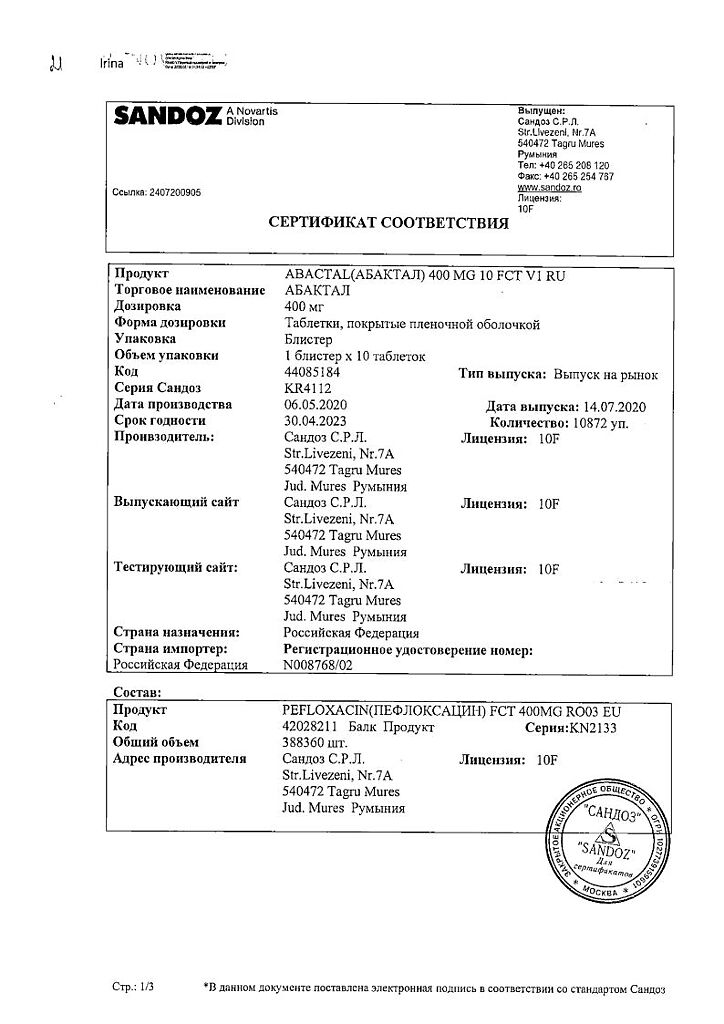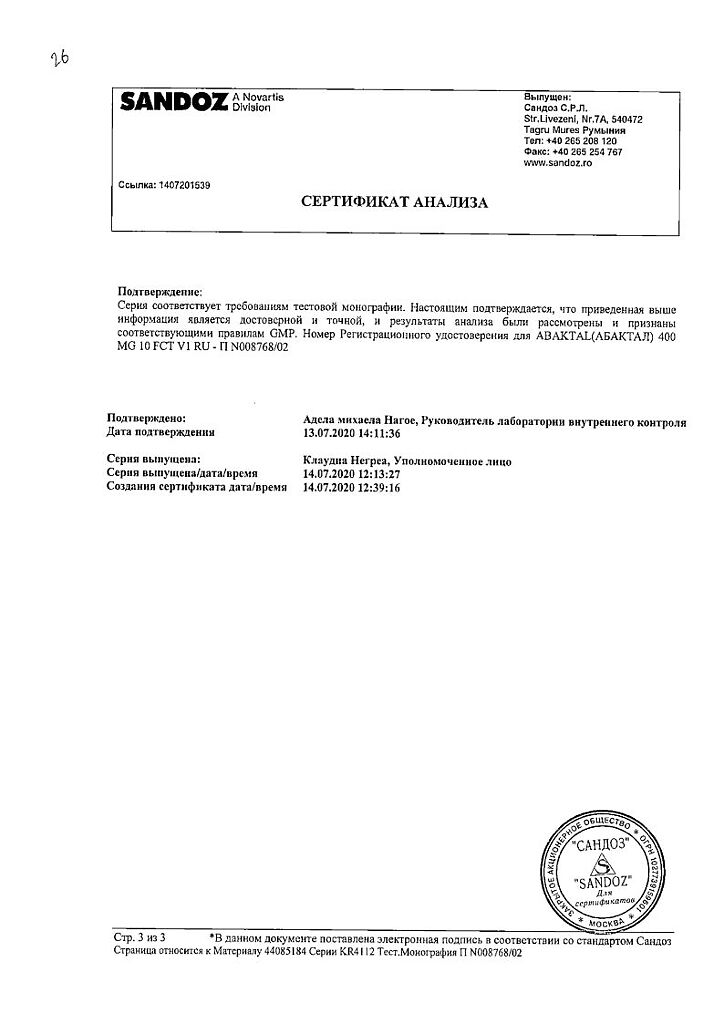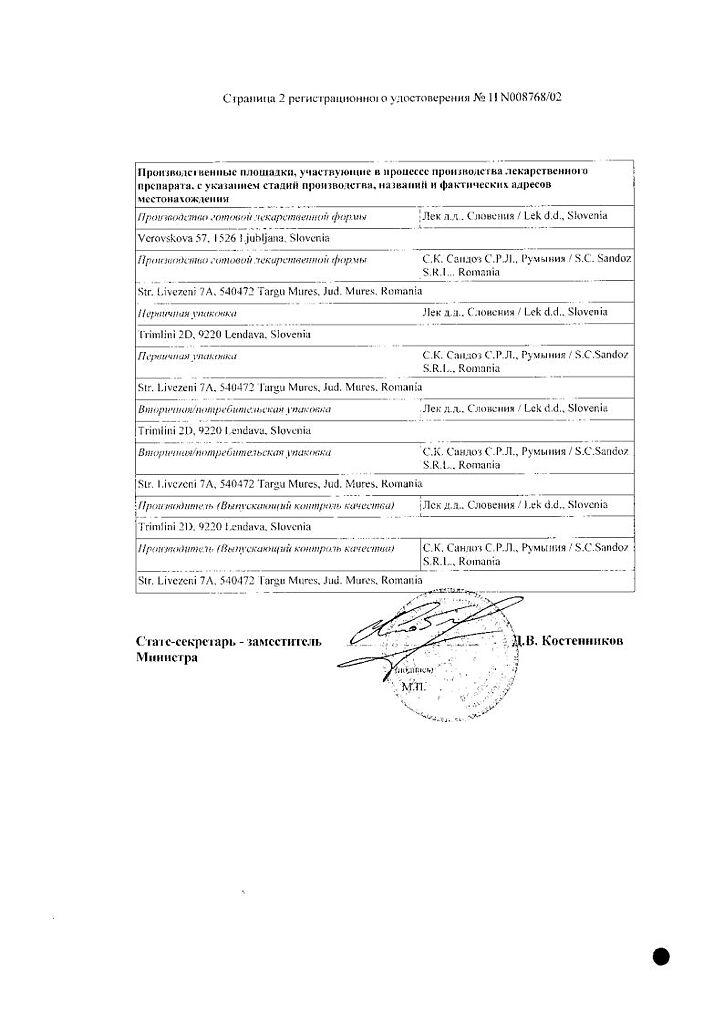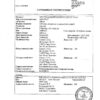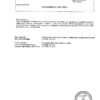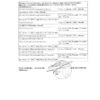No products in the cart.
Description
Antimicrobial agent – fluoroquinolone.
ATX code: J01MA03
Pharmacodynamics
Pefloxacin is a synthetic antimicrobial agent of the group of fluoroquinolones. It acts bactericidally by inhibiting the enzyme DNA-Giase and bacterial DNA replication; it also disrupts ribonucleic acid A-subunit replication and protein synthesis by the bacterial cell. With respect to Gram-negative bacteria, it acts on cells in both resting and dividing phases; with respect to Gram-positive bacteria, it acts only on cells in the process of mitotic division.
Pefloxacin has a broad spectrum of antimicrobial action.
The following microorganisms are sensitive to pefloxacin: Aeromonas hydrophila, Campylobacter jejuni, Citrobacter spp, Enterobacter spp, Escherichia coli, Haemophilus ducreyi, Haemophilus influenzae, Klebsiella spp., Legionella pneumophilla, Moraxella catarrhalis, Morganella morganii, Pasteurella multocida, Proteus mirabilis, indole positive Proteus, Providencia stuartii, Salmonella spp, Serratia spp., Shigella spp., Vibrio cholerae.
Moderate sensitivity to the drug has: Streptococcus spp, except Streptococcus pneumoniae; Acinetobacter spp., Neisseria gonorrhoeae, Neisseria meningitidis, Staphylococcus aureus, Chlamydia trachomatis.
Clostridium perfringens, Enterococcus spp, Gardnerella vaginalis, Gram-negative anaerobic microorganisms, spirochetes (Treponema spp., Borrelia spp, Leptospira spp.), Pseudomonas aeruginosa, Mycoplasma spp, Ureaplasma urealyticum and Mycobacterium tuberculosis.
Pharmacokinetics
Absorption
Absorption is high: within 20 minutes after oral administration 90% of pefloxacin is absorbed in the gastrointestinal tract (GIT). After a single oral intake of 200 or 400 mg of pefloxacin per day by healthy volunteers within 1-1.5 hours the maximum plasma concentrations (Cmax) were 2.5 and 4.3 mcg/ml, respectively.
When repeated oral administration of 400 mg of pefloxacin twice daily, maximum and residual concentrations of pefloxacin are reached after 48 hours: maximum serum concentrations range from 7.9 to 10 mcg/ml, residual serum concentrations, just before the next dose, are 3.8 mcg/ml.
The area under the curve “drug concentration/time” (AUC) when administered orally and intravenously is the same, indicating complete absorption of pefloxacin and is 29.5 mg/ml/h.
Distribution
The degree of binding to plasma proteins is 20-30 %, volume of distribution – 1.7 l/kg, providing uniform distribution in organs and tissues. Due to the high volume of distribution the drug penetrates quickly and is well distributed in the tissues, organs and body fluids.
Metabolism
Pefloxacin is metabolized in the liver to form 5 metabolites, 4 of which are found in the urine. The 2 main metabolites are pefloxacin-N-oxide, which has minimal antibacterial activity, and N-dimethyl-pefloxacin, which has antibacterial properties.
However, its concentration is minimal and amounts to 2-3% of pefloxacin concentration.
Excretion
In patients with normal renal and hepatic function 59% of the dose taken is excreted by the kidneys unchanged and as two major metabolites. In general, 60% of the dose is excreted by the kidneys and 40% by the intestine. 20% of the administered dose was excreted as N-dimethyl-pefloxacin and 16.2% as pefloxacin-N-oxide.
The drug is reabsorbed in renal tubules. Renal clearance of pefloxacin is low, varying from 0.11 to 0.21 ml per second depending on the dose. The half-life (T½) of the drug after single administration is 10.5 hours, and increases to 12.3 hours with multiple oral administration. However, pefloxacin and its metabolites are detected in the urine within 48 hours after usage.
Also 20-30% of pefloxacin is excreted with the bile as pefloxacin-glucuronide and N-oxide derivatives. Within 12 hours after oral administration of 400 mg of pefloxacin its concentration in bile reached 83 µg/ml.
Pharmacokinetics in special patient groups
In renal disorders plasma concentration of pefloxacin and T½ is almost unchanged due to the fact that hepatic clearance of the drug is the main excretion mechanism.
In impaired liver function, plasma clearance of pefloxacin is significantly reduced and T½ is correspondingly increased.
Indications
Indications
Treatment of infectious and inflammatory diseases caused by microorganisms sensitive to pefloxacin:
complicated urinary tract infections;
bacterial prostatitis;
lower respiratory tract infections (exacerbation with cystic fibrosis, nosocomial pneumonia);
infections of the abdominal cavity and hepatobiliary system;
severe bacterial infections of the gastrointestinal tract, including salmonellosis;
infections of bones and joints (osteomyelitis caused by gram-negative microorganisms);
skin and soft tissue infections;
bacterial endocarditis;
meningitis (if the pathogen is sensitive only to pefloxacin);
gonorrhea.
For the treatment of the following infectious and inflammatory diseases, pefloxacin can only be used as an alternative to other antimicrobial drugs:
acute sinusitis;
exacerbation of chronic bronchitis;
uncomplicated urinary tract infections.
Pefloxacin is used as monotherapy or in combination therapy with other antimicrobial agents.
Pefloxacin is effective in the treatment and prevention of infections in immunocompromised patients.
Current official guidelines on the use of antibacterial agents must be taken into account.
Pharmacological effect
Pharmacological effect
Antimicrobial agent – fluoroquinolone.
ATX code: J01MA03
Pharmacodynamics
Pefloxacin is a synthetic antimicrobial drug from the group of fluoroquinolones. Acts bactericidal, inhibiting the enzyme DNA gyrase and bacterial DNA replication; also disrupts the replication of the A-subunit of ribonucleic acid and the synthesis of proteins by the bacterial cell. In relation to gram-negative bacteria, it acts on cells that are both in the resting phase and in the division phase; in relation to gram-positive bacteria – only on cells that are in the process of mitotic division. A post-antibiotic effect is characteristic.
Pefloxacin has a broad spectrum of antimicrobial action.
The following microorganisms are sensitive to pefloxacin: Aeromonas hydrophila, Campylobacter jejuni, Citrobacter spp., Enterobacter spp., Escherichia coli, Haemophilus ducreyi, Haemophilus influenzae, Klebsiella spp., Legionella pneumophilla, Moraxella catarrhalis, Morganella morganii, Pasteurella multocida, Proteus mirabilis, indole-positive Proteus, Providencia stuartii, Salmonella spp., Serratia spp., Shigella spp., Vibrio cholerae.
The following are moderately sensitive to the drug: Streptococcus spp., except Streptococcus pneumoniae; Acinetobacter spp., Neisseria gonorrhoeae, Neisseria meningitidis, Staphylococcus aureus, Chlamydia trachomatis.
Resistant are: Clostridium perfringens, Enterococcus spp., Gardnerella vaginalis, gram-negative anaerobic microorganisms, spirochetes (Treponema spp., Borrelia spp., Leptospira spp.), Pseudomonas aeruginosa, Mycoplasma spp, Ureaplasma urealyticum and Mycobacterium tuberculosis.
Pharmacokinetics
Absorption
Absorption is high: within 20 minutes after oral administration, 90% of pefloxacin is absorbed from the gastrointestinal tract (GIT). After a single oral dose of 200 or 400 mg of pefloxacin per day to healthy volunteers for 1-1.5 hours, the maximum concentrations (Cmax) in blood plasma were 2.5 and 4.3 μg/ml, respectively.
With repeated oral administration of 400 mg of pefloxacin twice a day, the maximum and residual concentrations of pefloxacin are achieved after 48 hours: the maximum concentration in the blood serum varies from 7.9 to 10 μg/ml, the residual concentration in the serum immediately before the next dose is 3.8 μg/ml.
The area under the drug concentration/time curve (AUC) for oral and intravenous administration is the same, which indicates complete absorption of pefloxacin and is 29.5 mg/ml/h.
Distribution
The degree of binding to plasma proteins is 20–30%, the volume of distribution is 1.7 l/kg, which ensures uniform distribution throughout organs and tissues. Thanks to the high volume of distribution, it quickly penetrates and is well distributed in tissues, organs and body fluids.
Metabolism
Pefloxacin is metabolized in the liver, producing 5 metabolites, 4 of which are found in the urine. The 2 main metabolites are pefloxacin-N-oxide, which has minimal antibacterial activity, and N-dimethyl-pefloxacin, which has antibacterial properties.
However, its concentration is minimal and amounts to 2-3% of the concentration of pefloxacin.
Removal
In patients with normal renal and hepatic function, 59% of the dose taken is excreted by the kidneys unchanged and in the form of two main metabolites. In general, 60% of the dose is excreted by the kidneys and 40% by the intestines. 20% of the dose taken was excreted as N-dimethyl-pefloxacin and 16.2% as pefloxacin-N-oxide.
The drug is reabsorbed in the renal tubules. The renal clearance of pefloxacin is low, depending on the dose, varying from 0.11 to 0.21 ml per second. The half-life (T½) of the drug after a single use is 10.5 hours, and with repeated oral use it increases to 12.3 hours. However, pefloxacin and its metabolites are detectable in urine within 48 hours after use.
Also, 20-30% of pefloxacin is excreted in the bile in the form of pefloxacin glucuronide and N-oxide derivatives. Within 12 hours after oral administration of 400 mg of pefloxacin, its concentration in bile reached 83 mcg/ml.
Pharmacokinetics in special groups of patients
In case of impaired renal function, the plasma concentration of pefloxacin and T½ practically do not change due to the fact that hepatic clearance of the drug is the main mechanism of elimination.
If liver function is impaired, the plasma clearance of pefloxacin is significantly reduced, and T½ increases accordingly.
Special instructions
Special instructions
Abaktal® is used as monotherapy or in combination therapy with other antimicrobial agents.
For mixed infections, for perforative processes in the abdominal cavity, for severe bacterial infections of the gastrointestinal tract, the drug Abactal® is combined with drugs active against anaerobes (metronidazole, clindamycin).
During treatment, patients should receive plenty of fluids (to prevent crystalluria).
Photosensitivity
Due to the possible occurrence of a photosensitivity reaction, during treatment with Abactal®, you should not be exposed to UV radiation or prolonged exposure to direct sunlight. If any changes appear on the skin, treatment should be stopped. Direct sunlight should be avoided for 4 days after stopping therapy, otherwise it is recommended to use protective clothing or a protective cream (with a high level of UV protection).
Liver failure
For patients with severe liver disease, dose adjustment is required in proportion to the degree of damage (see section “Dosage and Administration”).
Musculoskeletal system
Tendinitis that occurs during treatment with pefloxacin can lead to tendon rupture (eg, Achilles tendon). Sometimes bilateral tendinitis may develop within 48 hours after starting treatment with Abactal®, as well as several months after stopping treatment with the drug. Risk factors for the development of tendonitis during fluoroquinolone therapy include: age over 60 years, renal failure, dialysis, concomitant therapy with glucocorticosteroids, dyslipidemia. If initial signs of tendinitis occur, treatment with pefloxacin should be discontinued, weight-bearing on the affected limb should be avoided, and a doctor should be consulted.
To reduce the risk of tendinopathy:
It is recommended to treat elderly patients after careful assessment of the balance of benefits and risks. The risk can be reduced by using half doses of the drug;
The use of pefloxacin is contraindicated in patients with a history of tendinitis; it is recommended to avoid use in patients receiving glucocorticosteroids or engaging in intense physical exercise.
The risk of rupture is higher in patients who begin to walk after prolonged bed rest.
When initiating pefloxacin therapy, it is recommended to monitor the Achilles tendon for pain and swelling, especially in patients at risk. If these symptoms are detected, pefloxacin should be discontinued, stress should not be placed on the affected tendons and they should be supported with a suitable orthosis or orthopedic shoes, even if the lesion is unilateral. You should seek advice from a specialist.
Dysglycemia
As with other fluoroquinolones, changes in blood glucose concentrations, including hypo- and hyperglycemia, are possible when using pefloxacin. During therapy with pefloxacin, dysglycemia may occur more often in elderly patients and patients with diabetes mellitus receiving concomitant therapy with oral hypoglycemic drugs (for example, sulfonylureas) or insulin. When using pefloxacin in such patients, the risk of developing hypoglycemia, including hypoglycemic coma, increases.
It is necessary to inform patients about the symptoms of hypoglycemia (confusion, dizziness, ravenous appetite, headache, nervousness, palpitations or increased heart rate, pale skin, perspiration, trembling, weakness). If the patient develops hypoglycemia, treatment with pefloxacin should be discontinued immediately and appropriate therapy should be initiated. In these cases, it is recommended to switch to therapy with an antibiotic other than a fluoroquinolone, if possible. When treating with pefloxacin in elderly patients and patients with diabetes mellitus, careful monitoring of blood glucose concentrations is recommended.
Nervous system disorders
Sensory and sensorimotor peripheral neuropathy, which may have a rapid onset, has been reported in patients receiving fluoroquinolones, including pefloxacin. If the patient develops symptoms of peripheral neuropathy, the use of pefloxacin should be discontinued (minimizes the possible risk of developing irreversible changes). Pefloxacin should be used with caution in patients with myasthenia gravis.
Pefloxacin should be used with caution in elderly patients with cerebrovascular accident, organic brain changes or stroke.
Pefloxacin should be used with caution in patients with a history of seizures and conditions predisposing to their development, in patients with porphyria.
The development of adverse reactions associated with mental disorders is possible even after a single dose.
In the event of the development of any side effects from the central nervous system, including mental disorders, it is necessary to immediately discontinue Abactal® and begin appropriate therapy. In these cases, it is recommended to switch to therapy with an antibiotic other than a fluoroquinolone, if possible.
Visual disorders
If visual acuity decreases or other effects on the organ of vision are observed, you should immediately consult an ophthalmologist.
Gastrointestinal tract
Diarrhea (especially if severe, persistent and/or bloody) during or after use of Abactal® may be a symptom of disease caused by Clostridium difficile, the most severe form of which is pseudomembranous colitis. If pseudomembranous colitis is suspected, the use of Abactal should be stopped immediately and symptomatic treatment (eg, oral vancomycin) should be given. In this condition, drugs that reduce peristalsis are contraindicated.
Heart disorders
QT interval prolongation has been reported in patients receiving fluoroquinolones. Despite the fact that pefloxacin can be classified as a group of fluoroquinolones that have a very low potential or do not have sufficient information necessary to assess their potential ability to cause prolongation of the QT interval, caution should be exercised in cases of congenital long QT interval syndrome, heart disease (heart failure, myocardial infarction, bradycardia); electrolyte imbalance (for example, with hypokalemia, hypomagnesemia), with simultaneous use of pefloxacin with drugs that can prolong the QT interval (for example, class IA and III antiarrhythmic drugs; antipsychotic drugs (pimozide, haloperidol, phenothiazine derivatives); tricyclic antidepressants, some antimicrobial drugs (erythromycin, sparfloxacin, moxifloxacin, antimalarial drugs, macrolides); some antihistamines (astemizole), as the risk of developing life-threatening arrhythmias increases.
Aneurysm and aortic dissection
Epidemiological studies have reported an increased risk of aortic aneurysm and aortic dissection following the use of fluoroquinolones, especially in elderly patients.
Therefore, fluoroquinolones should be used only after careful benefit-risk assessment and consideration of other treatment options in patients with a family history of aortic aneurysm or in patients with a known aortic aneurysm and/or aortic dissection, or in the presence of other risk factors or conditions predisposing to the development of aortic aneurysm or aortic dissection (eg, Marfan syndrome, Ehlers-Danlos vascular type, Takayasu arteritis, giant cell arteritis, Behcet’s disease, arterial hypertension, atherosclerosis).
If patients experience sudden pain in the abdomen, chest, or back, they should seek immediate medical attention at an emergency room.
Glucose-6-phosphate dehydrogenase deficiency
The development of hemolytic reactions has been reported when using fluoroquinolones in patients with glucose-6-phosphate dehydrogenase deficiency. Although hemolysis has not been reported with pefloxacin, this antibiotic should be avoided in these patients and the use of an alternative treatment option if available is recommended.
Sustainability
As with other antibiotics, the use of pefloxacin, especially long-term, can lead to the proliferation of insensitive microorganisms. Re-evaluation of the patient’s condition is mandatory. If a secondary infection develops during treatment, appropriate measures should be taken.
Effect on laboratory tests
False-positive results may occur when determining opiates in urine. Positive results may need to be confirmed using more specific methods.
Pefloxacin does not affect tests that measure urinary glucose concentrations.
Hypersensitivity
Hypersensitivity and allergic reactions, including anaphylactic reactions, may result from the use of pefloxacin and may be life-threatening.
If a hypersensitivity reaction develops, pefloxacin should be discontinued and appropriate therapy should be initiated.
Disability and potential irreversible serious adverse reactions associated with fluoroquinolones
In patients using quinolones and fluoroquinolones, regardless of age or the presence of pre-existing risk factors, there have been very rare cases of long-term (over several months or years), disabling and potentially irreversible severe adverse reactions affecting various body systems, sometimes several systems (musculoskeletal system, nervous system, mental and sensory organs, including reactions such as tendonitis, tendon damage, arthralgia, pain in the body). limbs, gait disturbance, neuropathies associated with paresthesia, depression, fatigue, memory impairment, sleep disturbances, and impairment of hearing, vision, taste and smell).
Pefloxacin should be discontinued immediately at the first sign or symptom of any severe adverse reaction and patients are advised to seek medical advice. The use of pefloxacin is not recommended in patients who have previously experienced serious adverse reactions with quinolones or fluoroquinolones.
Active ingredient
Active ingredient
Pefloxacin
Composition
Composition
1 tablet contains:
active ingredient:
pefloxacin mesylate dihydrate 558.50 mg (equivalent to pefloxacin 400.00 mg);
excipients:
lactose monohydrate 79.50 mg,
corn starch 32.00 mg,
povidone 32.00 mg,
sodium carboxymethyl starch 32.00 mg,
talc 27.00 mg,
colloidal silicon dioxide (anhydrous) 2.00 mg,
magnesium stearate 7.00 mg;
shell composition: hypromellose 13.166 mg, titanium dioxide 2.090 mg, talc 0.854 mg, macrogol 400 1.790 mg, carnauba wax 0.100 mg.
Pregnancy
Pregnancy
During pregnancy, the use of Abactal® is contraindicated.
Pefloxacin passes into breast milk in large quantities (75% serum concentration). Therefore, while using the drug, it is necessary to stop breastfeeding.
Contraindications
Contraindications
hypersensitivity to fluoroquinolones and/or other components of the drug;
lactase deficiency, lactose intolerance, glucose-galactose malabsorption syndrome;
severe liver dysfunction;
deficiency of glucose-6-phosphate dehydrogenase;
a history of tendon lesions that occurred during previous treatment with fluoroquinolones;
children under 18 years of age (due to the risk of severe forms of arthropathy, especially large joints);
pregnancy and breastfeeding period.
With caution
Neurological disorders (epilepsy, convulsive syndrome of unknown etiology, severe organic damage to the central nervous system, cerebrovascular accidents, peripheral neuropathy); renal dysfunction; mild to moderate liver dysfunction, elderly patients, congenital long QT syndrome, heart disease (heart failure, myocardial infarction, bradycardia), electrolyte imbalance (for example, hypokalemia, hypomagnesemia), simultaneous use of drugs that prolong the QT interval (including class IA and III antiarrhythmics, tricyclic and tetracyclic antidepressants, neuroleptics, macrolides, antifungals, imidazole derivatives, some antihistamines), simultaneous use with glucocorticosteroids, isoniazid, oral hypoglycemic drugs, insulin; porphyria; myasthenia gravis; diabetes mellitus; psychosis, history of mental illness; severe adverse reactions to other quinolones or fluoroquinolones; patients with a family history of aortic aneurysm, or patients with a known history of aortic aneurysm and/or aortic dissection or the presence of other risk factors or conditions predisposing to the development of aortic aneurysm or aortic dissection (eg, Marfan syndrome, vascular Ehlers-Danlos syndrome, Takayasu arteritis, giant cell arteritis, Behçet’s disease, hypertension, atherosclerosis) (see section “Special instructions”).
Side Effects
Side Effects
According to the World Health Organization (WHO), adverse reactions are classified according to their frequency as follows: very common (≥1/10), common (≥1/100, <1/10), uncommon (≥1/1000, <1/100), rare (≥1/10000, <1/1000) and very rare (<1/10000); frequency unknown - based on available data, it was not possible to determine the frequency of occurrence.
Infectious and parasitic diseases: frequency unknown: candidiasis.
Blood and lymphatic system disorders
uncommon: eosinophilia;
rarely: thrombocytopenia;
frequency unknown: anemia, leukopenia, neutropenia, pancytopenia, agranulocytosis.
Endocrine system disorders: frequency unknown: syndrome of inappropriate secretion of antidiuretic hormone.
Immune system disorders: frequency unknown: angioedema, anaphylactic shock.
Metabolic and nutritional disorders: frequency unknown: severe hypoglycemia, up to the development of hypoglycemic coma, especially in elderly patients, patients with diabetes mellitus, taking oral hypoglycemic drugs or insulin.
Mental disorders: frequency unknown: increased fatigue, depression, psychosis, attention disorders, disorientation, agitation, nervousness, memory impairment, delirium.
Nervous system disorders:
often: insomnia;
uncommon: headache, dizziness;
rarely: increased irritability, hallucinations;
frequency unknown: confusion, convulsions (including epileptic seizures), intracranial hypertension (especially in young people after long-term therapy with pefloxacin, characterized by a favorable prognosis; in most cases resolved after discontinuation of therapy and adequate treatment), paresthesia, myoclonus (sudden short-term twitching of individual muscles or muscles of the whole body), sensory or sensory-motor peripheral neuropathy, increased convulsive readiness, anxiety, agitation, “nightmare” dreams, exacerbation of myasthenia gravis, tremor.
Visual disorders: frequency unknown: visual disturbances.
Cardiac disorders: frequency unknown: QT interval prolongation.
Respiratory, thoracic and mediastinal disorders: frequency unknown: bronchospasm.
Gastrointestinal disorders:
often: nausea, vomiting, stomach pain;
uncommon: diarrhea;
rarely: pseudomembranous colitis;
frequency unknown: change in taste, decreased appetite, flatulence.
Liver and biliary tract disorders:
rarely: transient increase in the activity of “liver” transaminases, as well as alkaline phosphatase and bilirubin concentration in the blood plasma;
frequency unknown: cholestatic jaundice, hepatitis, liver necrosis.
Skin and subcutaneous tissue disorders:
often: skin rash, urticaria;
uncommon: photosensitivity reactions (both to sunlight and ultraviolet (UV) radiation);
rarely: skin itching, erythema;
frequency unknown: exudative erythema multiforme, toxic epidermal necrolysis (Lyell’s syndrome), Stevens-Johnson syndrome, skin hyperemia, vascular purpura, photoonycholysis.
Musculoskeletal and connective tissue disorders:
often: myalgia, arthralgia;
frequency unknown: arthropathy, tendonitis, tendon rupture, joint effusion.
Renal and urinary tract disorders:
very rarely: acute renal failure;
frequency unknown: crystalluria, glomerulonephritis, dysuria, interstitial nephritis.
Interaction
Interaction
Synergistic and additive effects are achieved by combining pefloxacin with rifampicin (it should be remembered that rifampicin significantly increases the plasma clearance of pefloxacin, therefore, when using these drugs together, plasma concentrations of pefloxacin in the blood serum should be monitored), beta-lactam antibiotics (when treating staphylococcal infections).
Aminoglycosides, piperacillin, azlocillin, ceftazidime enhance the antibacterial effect (including for Pseudomonas aeruginosa infection).
Pefloxacin reduces the metabolism of theophylline in the liver, which leads to an increase in its concentration in the blood plasma and the central nervous system. This may result in an increased frequency and/or severity of side effects, which in rare cases can be life-threatening or fatal. Therefore, when using theophylline and pefloxacin simultaneously, the plasma concentration of theophylline should be monitored and its dose reduced if necessary.
Pefloxacin may reduce the prothrombin index (in patients taking oral (indirect) anticoagulants). The degree of anticoagulant effect may vary depending on the nature of the disease, age and general condition of the patient. Therefore, monitoring of the International Normalized Ratio (INR) is necessary during and for some time after the combined use of pefloxacin and oral anticoagulants.
Cimetidine, ranitidine and other inhibitors of microsomal liver enzymes increase T1/2 of pefloxacin and increase its toxicity.
Antacids (containing aluminum or magnesium) and preparations containing iron and zinc, as well as didanosine (only didanosine dosage forms containing aluminum or magnesium compounds as a buffer) slow down the absorption of pefloxacin. In this regard, pefloxacin must be taken at least 2 hours before using these medications or 4-6 hours after. No clinically significant interaction has been identified between pefloxacin and calcium carbonate.
With the combined use of fluoroquinolones and cyclosporine, an increase in the concentration of creatinine and cyclosporine in the blood plasma is possible.
Caution must be exercised when used concomitantly with isoniazid.
Pefloxacin can be used in combination with metronidazole and vancomycin.
When used together with tetracycline and chloramphenicol, antagonism is observed.
When pefloxacin is used together with glucocorticosteroids (especially in patients over 60 years of age, in patients with impaired renal function and in patients with dyslipidemia), the risk of adverse events (tendonitis and, in very rare cases, Achilles tendon damage) increases. In view of this, the combined use of pefloxacin and glucocorticosteroids should be avoided.
Due to a decrease in the activity of microsomal oxidation processes in hepatocytes, it increases the concentration and lengthens T1/2 of oral hypoglycemic agents.
Pefloxacin may prolong the QT interval, so caution should be exercised when used concomitantly with drugs that can prolong the QT interval (for example, class IA and III antiarrhythmic drugs; antipsychotic drugs (pimozide, haloperidol, phenothiazine derivatives); tricyclic antidepressants, some antimicrobial drugs (erythromycin, sparfloxacin, moxifloxacin, antimalarials drugs, macrolides); some antihistamines (astemizole), as the risk of developing life-threatening arrhythmias increases.
Overdose
Overdose
Symptoms: nausea, vomiting, confusion, psychomotor agitation, in severe cases, loss of consciousness, convulsions, prolongation of the QT interval.
Treatment: the patient should be under medical supervision. It is necessary to ensure sufficient fluid intake into the body. Treatment is symptomatic. Hemodialysis is ineffective.
Storage conditions
Storage conditions
Store in original packaging (blister in a pack), at a temperature not exceeding 25 °C.
Keep out of the reach of children.
Shelf life
Shelf life
3 years. Do not use the drug after the expiration date indicated on the package!
Manufacturer
Manufacturer
S.C. Sandoz S.r.L., Romania
Additional information
| Shelf life | 3 years. Do not use the drug after the expiration date stated on the package! |
|---|---|
| Conditions of storage | Store in the original package (blister in the pack) at a temperature not exceeding 25 ° C. Keep out of reach of children. |
| Manufacturer | С. К. Sandoz S.r.l., Romania |
| Medication form | pills |
| Brand | С. К. Sandoz S.r.l. |
Related products
Buy Abaktal, 400 mg 10 pcs with delivery to USA, UK, Europe and over 120 other countries.


